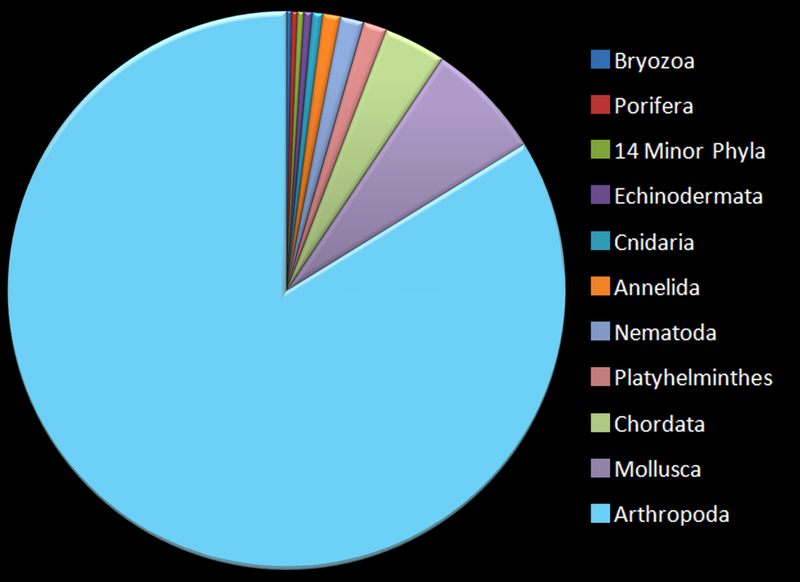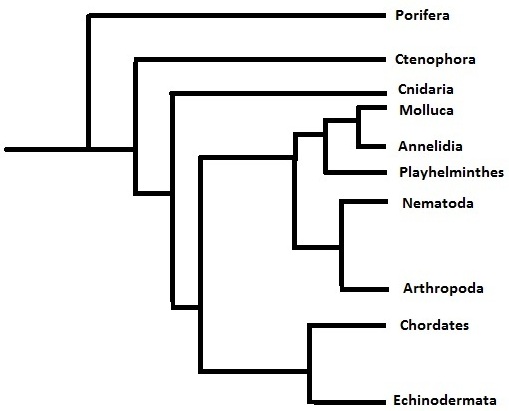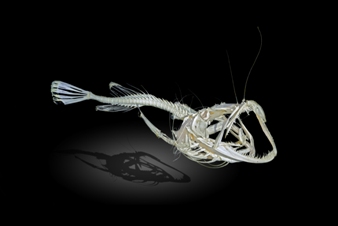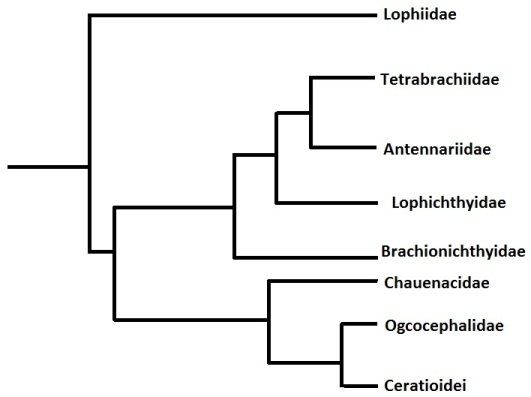Where Does this Fish Fit in?
The classification of an species not only a way to identify the general characteristics an organism possess, but it also tells you how it relates to other species and where it fits in the world. Most known species are classified in this way and the anglerfish is no different.
Domain: Eukarya
Kingdom: Animalia
Phylum: Chordata
Class: Osteichthyes
Order: Lophiiformes
Family: Lophiidae
Genus: Lophius
Species: Lophius piscatorius
Domain: Eukarya
There are 3 domains into which life is catego rized:
Bacteria, Archaea and Eukarya. The organisms in the domain Eukarya are set
apart from other organisms by shared characteristics, or
synapomorphies. Every organism in the domain, including
Lophius piscatorius, posses a nucleus, has membrane bound
organelles, and cells that divide in either mitosis or meiosis.
These synapomorphies are the key to the complex organisms that
fall into the domain Eukarya (Campbell and Reece et. al 2009).
Some of my other favorite Eukaryotes are the
American crocodile, the
Giant Pacific Octopus.
rized:
Bacteria, Archaea and Eukarya. The organisms in the domain Eukarya are set
apart from other organisms by shared characteristics, or
synapomorphies. Every organism in the domain, including
Lophius piscatorius, posses a nucleus, has membrane bound
organelles, and cells that divide in either mitosis or meiosis.
These synapomorphies are the key to the complex organisms that
fall into the domain Eukarya (Campbell and Reece et. al 2009).
Some of my other favorite Eukaryotes are the
American crocodile, the
Giant Pacific Octopus.
Kingdom: Animalia
The Animalia or animal kingdom is probably one of the first
groups of organism we learn to name as children. But , this group
doesn’t only contain warm cuddly mammals; it also encompasses
organisms like
sponges,
leeches and
flatworms. As depicted in
the circle graph to the above, chordates only take up a small portion of
the tree. The phylogenetic tree to the left depicts some
animal phyla based on morphological data. Everything that is considered an animal develops from
2 different haploid gametes through the process of meiosis.
During development animals in this grouping are all motile at
some point. Since animals are not able to photosynthesize, they
have to obtain their food from another source therefore they are
heterotrophic. In order to keep up with their increasing
complexity, most animals have some sort of circulatory,
respiratory and/or digestive system (Linnaeus 1758).
, this group
doesn’t only contain warm cuddly mammals; it also encompasses
organisms like
sponges,
leeches and
flatworms. As depicted in
the circle graph to the above, chordates only take up a small portion of
the tree. The phylogenetic tree to the left depicts some
animal phyla based on morphological data. Everything that is considered an animal develops from
2 different haploid gametes through the process of meiosis.
During development animals in this grouping are all motile at
some point. Since animals are not able to photosynthesize, they
have to obtain their food from another source therefore they are
heterotrophic. In order to keep up with their increasing
complexity, most animals have some sort of circulatory,
respiratory and/or digestive system (Linnaeus 1758).
 Phylum: Chordata
Phylum: Chordata
Anglerfish are also classified into the phylum Chordata. This
means that they are triploblastic deuterostomes, or have 3
tissue layers and develop their anus before their mouths
(Campbell and Reece et. al 2009). As you can see in the
phylogenetic tree above, chordates are most closely related to
echinoderms, which include animals like starfish and sea urchins.
The characteristic that unites this group is being deuterostomes. Chordates possess a notochord and gill slits at
some point in their life, but eventually, in vertebrates, the
notochord is replaced with the vertebral column. This is what
happens in L. piscatorius (Linnaeus 1758). One
chordate prevalent in the Midwest is the
Eastern Grey Squirrel.
Class: Osteichthyes
Osteichthyes include all fish with some kind of a bony skeleton
fused to its teeth. Along with this many of this fish in this
group have a swim bladder, which is used to control its buoyancy
(Linnaeus 1758).
Order: Lophiiformes
As the grouping becomes more specific, so do the synapomorphies
that unite the group. The fish in the order Lophiiformes have no
ribs and posses an illicium. The absence of ribs allows for an
expandable stomach and larger meals. An illicium is the fishing
rod associated with the anglerfish that is used for catching
prey. This illicium is actually a reformed portion of the
dorsal spine; this is an extremely important evolutionary
adaption in the capture of prey for L. piscatorius
(Linnaeus 1758). The order Lophiiformes is shown in a
phylogenetic tree based on morphological features to the right.
Every family named at the tips of the branches has the
characteristics listed above.
and larger meals. An illicium is the fishing
rod associated with the anglerfish that is used for catching
prey. This illicium is actually a reformed portion of the
dorsal spine; this is an extremely important evolutionary
adaption in the capture of prey for L. piscatorius
(Linnaeus 1758). The order Lophiiformes is shown in a
phylogenetic tree based on morphological features to the right.
Every family named at the tips of the branches has the
characteristics listed above.
Family: Lophiidae
Unique to this family of fish, those in Lophiidae have a reduced body,
covered by thin and scaleless skin. Its teeth are slim
and curved. If that doesn’t sound weird enough,
these fish also have an extreme under bite similar to what you
might think of in a bulldog (Linnaeus 1758).
Genus: Lophius
Head and body of fish in the genus Lophius are even
more depressed than what is thought of with fish in the family Lophiidae. These animals also posses dorsal, pectoral and
vertebral fin rays. They are benthic and inhabit areas anywhere
from the shoreline to about 760m in depth (Linnaeus 1758).
Species: Lophius piscatorius
Along with all the characteristics discussed in the groups
above, L. piscatorius possess 2 dorsal fin rays that
are broad and flattened. The skin on its body is pale in color.
It also inhabits the open seabed in areas of shallow- 500m in
depth (Linnaeus 1758). The English meaning of the name
Lophius piscatorius has to do with the word fishing. It was
most likely named for the fishing rod structure located on its
head.
Return to Homepage
